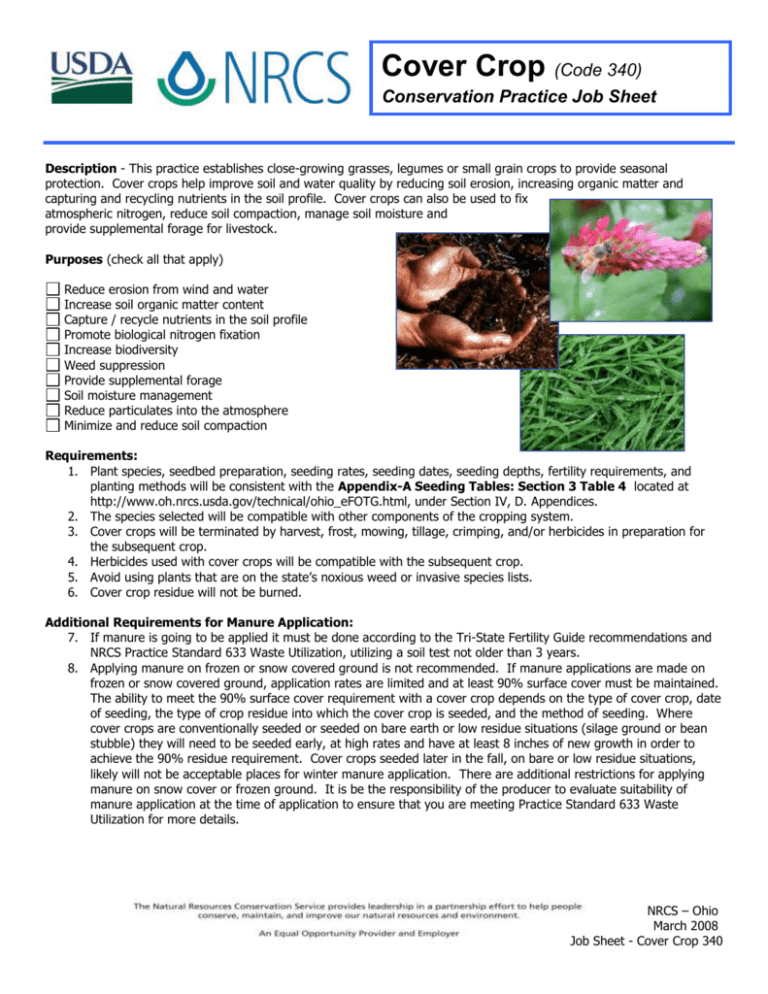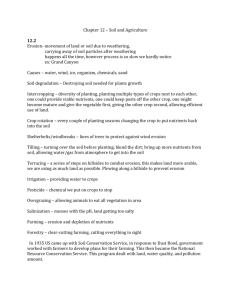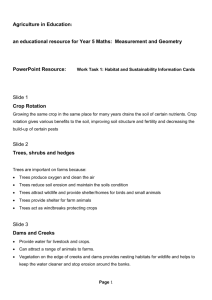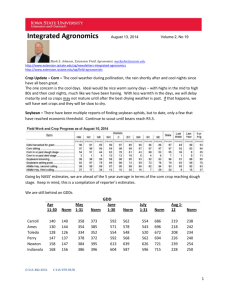Cover Crop Conservation Practice Job Sheet
advertisement

Cover Crop (Code 340) Conservation Practice Job Sheet Description - This practice establishes close-growing grasses, legumes or small grain crops to provide seasonal protection. Cover crops help improve soil and water quality by reducing soil erosion, increasing organic matter and capturing and recycling nutrients in the soil profile. Cover crops can also be used to fix atmospheric nitrogen, reduce soil compaction, manage soil moisture and provide supplemental forage for livestock. Purposes (check all that apply) Reduce erosion from wind and water Increase soil organic matter content Capture / recycle nutrients in the soil profile Promote biological nitrogen fixation Increase biodiversity Weed suppression Provide supplemental forage Soil moisture management Reduce particulates into the atmosphere Minimize and reduce soil compaction Requirements: 1. Plant species, seedbed preparation, seeding rates, seeding dates, seeding depths, fertility requirements, and planting methods will be consistent with the Appendix-A Seeding Tables: Section 3 Table 4 located at http://www.oh.nrcs.usda.gov/technical/ohio_eFOTG.html, under Section IV, D. Appendices. 2. The species selected will be compatible with other components of the cropping system. 3. Cover crops will be terminated by harvest, frost, mowing, tillage, crimping, and/or herbicides in preparation for the subsequent crop. 4. Herbicides used with cover crops will be compatible with the subsequent crop. 5. Avoid using plants that are on the state’s noxious weed or invasive species lists. 6. Cover crop residue will not be burned. Additional Requirements for Manure Application: 7. If manure is going to be applied it must be done according to the Tri-State Fertility Guide recommendations and NRCS Practice Standard 633 Waste Utilization, utilizing a soil test not older than 3 years. 8. Applying manure on frozen or snow covered ground is not recommended. If manure applications are made on frozen or snow covered ground, application rates are limited and at least 90% surface cover must be maintained. The ability to meet the 90% surface cover requirement with a cover crop depends on the type of cover crop, date of seeding, the type of crop residue into which the cover crop is seeded, and the method of seeding. Where cover crops are conventionally seeded or seeded on bare earth or low residue situations (silage ground or bean stubble) they will need to be seeded early, at high rates and have at least 8 inches of new growth in order to achieve the 90% residue requirement. Cover crops seeded later in the fall, on bare or low residue situations, likely will not be acceptable places for winter manure application. There are additional restrictions for applying manure on snow cover or frozen ground. It is be the responsibility of the producer to evaluate suitability of manure application at the time of application to ensure that you are meeting Practice Standard 633 Waste Utilization for more details. NRCS – Ohio March 2008 Job Sheet - Cover Crop 340 Seeding Rates of Pure Live Seed (PLS) for Cover Crops and Suggested Uses Pure Stand Proportional Seeding /4 Seeding Rate Rates for Mixtures /1 /4 Species /1 3/4 1/2 1/3 1/4 (seeds (x 1000) (lb/A) /ft 2) lb/A Suggested Cover Crops for Recycling Nutrients 1. Cover crops will be established and actively growing before the expected period(s) of nutrient leaching. 2. Cover crop species will be selected for their ability to take up large amounts of nutrients from the rooting profile of the soil. Oats 15 22 65 49 33 22 16 Oilseed Radish 140 32 10 7.5 5 3.5 2.5 Rye, cereal /2 18 25 60 45 30 20 15 Sorghum/Sudan Grass 28 13 20 15 10 7 5 Suggested Cover Crops for Reducing Compaction 1. Select and manage cover crop species that will produce deep roots and large amounts of surface or root biomass to increase soil organic matter, improve soil structure, and increase soil moisture through better infiltration. Oilseed Radish 140 32 10 7.5 5 3.5 2.5 Ryegrass, annual /2 228 84 16 12 8 5 4 Suggested Cover Crops for Fixing Nitrogen 1. Only legumes or legume-grass mixtures will be established as cover crops. 2. The specific Rhizobium bacteria for the selected legume will either be present in the soil or the seed will be inoculated at the time of planting. Alfalfa (annual) 227 80 15 12 8 5 4 Alsike clover – Ladino clover 700-860 48-55 3 2.25 1.5 1 .75 Austrian Winter Pea /1 18 17 40 30 20 13 10 Hairy Vetch /3 20 6 12 9 6 4 3 Red clover 275 51 8 6 4 2.5 2 Soybeans 4 7 80 60 40 25 20 Suggested Cover Crops for Managing Soil Moisture 1. Terminate growth of the cover crop sufficiently early to conserve soil moisture for the subsequent crop. The residue of cover crops established for moisture conservation shall be left on the soil surface. 2. In areas of potential excess soil moisture, allow the cover crop to grow as long as possible to maximize soil moisture removal. Rye, cereal 18 37 90 68 45 30 23 Wheat, winter /2 15 28 80 60 40 27 15 Suggest Cover Crops for Additional Forage 1. Species will have desired forage traits, be palatable to livestock, and not interfere with production of the subsequent crop. 2. Forage provided by the cover crop may be hayed or grazed as long as sufficient biomass is left for resource protection. Turnip 190 8 2 1 Oats 15 30 87 65 44 29 22 Rye, cereal /2 18 45 109 Ryegrass, annual /2 228 126 24 18 12 8 6 Sorghum/Sudan Grass 28 15 23 Wheat, winter /2 15 40 116 Seeds/lb Footnotes: Job /1 Up to (4) legumes/forbs and/or (4) grasses suitable for site conditions may be mixed at pro-rated rates. Be sure to treat legume seed (thereby the soil) with the proper inoculant prior to seeding. /2 The use of grass crops before corn takes a higher degree of management due to the potential of creating a “green bridge effect” and subsequent problems with diseases, insects, and allelopathy. The grass cover crop should be killed at least two weeks prior to corn planting. /3 High level of management. /4 Increase seeding rates by 20% if aerial seeding or when seeding under poorer growing conditions. NRCS – Ohio March 2008 Job Sheet - Cover Crop 340 Cover Crop (Code 340) Conservation Practice Job Sheet Sheet Producer: Tract: Fields After the Following Crops Fields Species Rate / Acre Seeding Time Method of Seeding D = Drill B= Broadcast A = Aerial Date or Stage to Till or Kill Cover Crop For Questions Regarding the Application and Management of Cover Crops Contact __________ Method to Till of Kill Cover Crop __________ @ Phone NRCS – Ohio March 2008 Job Sheet - Cover Crop 340







